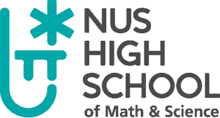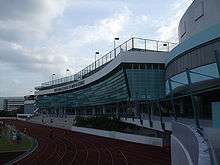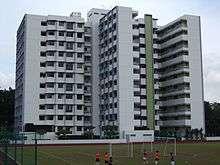NUS High School of Math and Science
| NUS High School of Math and Science | |
|---|---|
 | |
|
Experiment. Explore. Excel. | |
| Address | |
|
20 Clementi Avenue 1 Singapore 129957 | |
| Coordinates | 1°18′25″N 103°46′10″E / 1.306911°N 103.769356°ECoordinates: 1°18′25″N 103°46′10″E / 1.306911°N 103.769356°E |
| Information | |
| Type | Specialized Independent |
| Established | 1 January 2005 |
| Session | Single session |
| Principal | Mrs Lee Bee Yann |
| Gender | Co-ed |
| Age range | 13-18 |
| Enrolment | ≈ 980 |
| Student to teacher ratio | 10:1 |
| Language | English, Chinese, Malay, Tamil, Hindi, French, Japanese |
| Houses | Nobel, Fleming, Faraday, Fibonacci |
| Affiliation | National University of Singapore |
| Website |
www |
The NUS (National University of Singapore) High School of Math and Science is a specialised independent high school in Singapore offering a six-year Integrated Programme (IP) leading to the NUS High School Diploma.
The school offers an accelerated mathematics and science curriculum integrated with language arts, humanities, arts, sports, in a modular system. 90% of its graduates have pursued Science, Technology, Engineering and Medicine-related courses in University.
Curriculum
Academic curriculum
Though NUS High School is an Integrated Programme school, which means students bypass the O-levels, it does not offer A-level or International Baccalaureate programmes, unlike other Integrated Programme schools in Singapore. Instead, it offers a NUS High School Diploma, which is recognized by all universities in Singapore, as well as top universities worldwide; its academic rigour is comparable to the above-mentioned qualifications.
The diploma's curriculum is based on a modular system similar to NUS, where core modules are compulsory, elective modules help deepen the student's knowledge and may be compulsory for a major in a particular subject, and enrichment modules are purely for the student's interests. The school uses the cumulative average point (CAP) system, a 5-point system similar to the grade point average used in the United States.
Most notably, the school's mathematics and science curriculum is accelerated. Topics are usually covered earlier than normal; for example, the mole is introduced in Year 2 rather than in Year 3, some kinematics in Year 1 instead of Year 5, and molecular biology and genetics in Year 4 instead of Year 6. Examples of accelerated curriculum on mathematics include sections on solutions of equations in Year 1 rather than in Year 3, three-dimensional vectors and matrices in Years 2 and 4 instead of Year 5.
The school also offers honours courses in the Specialization Stage for mathematical and scientific disciplines, to further stretch the abilities of able students beyond the already-accelerated curriculum. The curriculum in these honours courses usually covers university material, such as linear algebra in mathematics, calculus-based electromagnetism in physics, organic synthesis and spectroscopy in chemistry, and proteomics in biology.
Students are also exposed to humanities and the arts, where the flexible modular system allows for a sampling across this discipline. Mother tongue is compulsory in the school, and complies with the Ministry of Education's guidelines and curriculum, and the English curriculum teaches students practical skills such as reading, writing, and public speaking.
To graduate with the NUS High School diploma, students must take Mathematics and at least two science subjects (which includes computing studies as well) at the major (basic) level in the Advancement Stage. Students may also choose to take a fourth subject from any subject group (sciences, humanities & the arts), and take any math/science subject at the honours level. In addition, students must complete an Advanced Research Project under the school's Da Vinci Research Programme. Finally, students must have a CAP above 2.5 (C+). Students are also encouraged to take Advanced Placement and Scholastic Assessment Test (SAT) examinations in their senior years for credits for admission into foreign universities, though these are not necessary for graduation.
To further develop talented students, NUS High School offers the following special academic programmes:
- Internationalisation Programme (exchange programmes with other math and science schools, Summer Academic Programmes)
- Einstein+ Programme (academic mentorship by NUS Professors, Olympiad training programme)
- Socrates Programme (for talented students in the humanities)
- Aesthetic Appreciation Programme
Research curriculum
All students must go through a research curriculum called the Da Vinci Programme, which is planned and managed by the Office of Research, Innovation and Enterprise. The program is structured as follows:
In Years 1 and 2, students participate in activities that stimulate creative thinking.
In Years 3 and 4, students take part in Independent Research Studies, which are structured to give students flexibility in conducting research. Students are required to complete a Research Methodology module and are encouraged to work on a research project under the guidance of a teacher-mentor. Students are also able to participate in external research programmes at institutions of higher education.
In Years 5 and 6, students must embark on a capstone project, an Advanced Research Project in an area of Math or Science. Typically, a graduation research project will take nine to eighteen months to complete, depending on the research topic, and it usually comprises at least two weeks of full-time research. Research projects are generally mentored by full-time academics at leading research institutions, universities or polytechnics. All students showcase their research at the school's annual Research Congress held in March, where they receive grades of Distinction, Merit, Pass or Fail.
Boarding Programme
Students are required to live in the NUS High Boarding School for the duration of their fifth year of study. This arrangement is meant to train independence and, more pragmatically, facilitate work on the Advanced Research Project, which usually takes place in science laboratories close to school. This scheme also increases accessibility for students taking modules at the nearby National University of Singapore. NUS High School Residence (Boarding School) boarding fees are subsidized for NUS High School Year 5 students by the Ministry of Education.
Campus
Campus facilities and features

The NUS High campus sits on 4.67 hectares of land off Clementi Ave 1, a few minutes walk from the outskirts of the National University of Singapore. The school shifted operations there from its holding site at the former Raffles Junior College in Mount Sinai where it had held classes in 2005. NUS High received an Honour Award from US-based DesignShare Awards programme for the innovative design of its affiliated NUS High School. The award is given to projects that exemplify "best practice innovation from around the world in designing for the future of learning".
The campus comprises 15 science laboratories, over eighty classrooms, a 700-seat auditorium, a 150-seat theatrette, and the NUS High School Residence (Boarding School).
The most notable of the school's facilities include a scanning electron microscope, which is housed in a science research lab called the "SEM room". Considering its high cost, it is rare for an institution of this size and level to have such a piece of equipment and as such it can only be accessed by teachers and students who are doing their research experiments. The school also has an observatory located on the roof of its Boarding School building that is often used by astronomy enthusiasts.
The school also has a Science Research Complex on the top floor. Six specialised research laboratories are located there (a life sciences lab, an analytical chemistry lab, a synthetic chemistry lab, an applied technology lab, a clean energy development lab and an infocomm technology lab). This is in addition to an IP video conferencing room, seminar rooms, and additional classrooms. The advanced facilities and scientific equipment, which are comparable to those available in universities, complement the 9 basic science laboratories located on the third floor of the school.
In addition, the campus has many publicised facades like the DNA nucleotides, the Nano-Tube, Math Walk, and the Periodic-Table. Other facilities include a field with a 400 m running track, one basketball court, two tennis courts, a netball court, a badminton court, a multi-purpose hall, environmental and eco-garden features, an exhibition concourse, a student lounge, five computer laboratories, a media resource room, and a library and canteen running alongside each other under the running track. The campus also has art and music studios and co-curricular activity rooms, as well as facilities for the disabled.
NUS High School Residence (Boarding School)

The campus includes a boarding school (NUS High School Residence) consisting of two blocks that can accommodate some 500 residents. Facilities include studying areas/rooms, library, gym, pantries, media rooms (TV and relaxation), multi-purpose function rooms and laundry rooms. The Residence is also open to scholars studying within or outside of the school and serves as the site for the school's boarding programme.
Attire and appearance
Uniform
Students wear the formal attire, a white collared shirt and light green long trousers (male) or skirts (female), together with the school tie and badge on Mondays, assemblies, public speeches, school functions, and any events where the students represent the school. Student Leaders, on special occasions or school functions, and students who represent the school for any competition or events, may be required to don grey blazers on top of the formal attire, together with dull-coloured shoes. On other days, students are allowed to wear their informal attire: a white polo shirt, together with either light green bermudas or long trousers (male), or skorts (female).
Affiliations to the National University of Singapore (NUS)
NUS Non-Graduating Programme
Only NUS High School students are eligible for the NUS Non-Graduating Programme. Under this programme, NUS High School students are allowed to read any NUS modules and courses from Faculty of Science (including Office of Life Sciences), Faculty of Engineering, Faculty of Arts and Social Sciences (Literature, History, Geography and Economics), and School of Computing, provided that students meet the minimum academic competency level as endorsed by a teacher.
Completed NUS modules are reflected in the student's transcript but are not included in the computation of their CAP. Should these students be admitted to NUS after graduation from the NUS High School, the module grade and module credit associated with the completed NUS modules can then be included in the computation of their NUS graduation degree/certification requirements and components. Students may also claim course credit for these modules at American universities.
NUS Libraries
The library at NUS High School is part of the NUS Library system. This avails the considerable loaning, catalog and transaction resources of NUS Libraries to NUS High School affiliates; NUS Teaching staff can request books located in any other NUS Library and have them transferred to the Library in NUS High School. All NUS High School students are able to obtain and have full electronic access to all journals available at NUSH Libraries.
Key partners
Parent institution
Strategic partners
- Agency for Science, Technology and Research (A*STAR)
- DSO National Laboratories
- Defence Science & Technology Agency (DSTA)
- Science Centre Singapore
Research/education partners
Principals
- 2005—2007: Associate Professor Lai Yee Hing
- 2007—2015: Dr Hang Kim Hoo
- 2016—present: Mrs Lee Bee Yann
Deputy Principals
- 2005-2007: Mrs Jennifer Pang
- 2005-2006: Mr Lim Ee Tuo
- 2006-2011: Mr Suresh s/o Balakrishnan
- 2008–Present: Ms Lim Hui Wen
- 2010–Present: Mr Chang Weng Fatt
- 2011–Present: Mr Goh Hock Leong
School organised events
National Mathematical Olympiad of Singapore (NMOS)
The National Mathematical Olympiad of Singapore is a national mathematical olympiad competition organized by the school in partnership with the Ministry of Education and Singapore Mathematical Society. Through this competition, the school aims to test the pupils attending the test's interest for maths.
NUS High School Annual Research Congress
The annual research congress organised by NUS High School Office of Research, Innovation and Enterprise is held in collaboration with the research programme (Da Vinci Programme). Every year, parents and guests from research organisations (Such as A*STAR, DSTA, DSO, NIE, NUS, etc.) are invited to this event where students' research works are showcased. The school also invites outstanding research projects from other Integrated Programme schools to be showcased alongside those of its own students, to promote collaboration and networking.
Singapore International Mathematics Challenge (SIMC)
The SIMC is a mathematical modelling competition co-organised by the NUS High and the Ministry of Education (Singapore), held every two years. In addition to the competition for students, symposiums and workshops are held for participating teachers and principals. Mathematical talents from around the world visit NUS High School for one week in May to sit for a mathematical competition paper, and to showcase their results to a panel of judges.
Singapore Amazing Machine Competition
The SAMC is a science competition jointly organised by the school, DSO National Laboratories, and the Science Centre Singapore. Teams construct a complex machine (the Amazing Machine) that performs a seemingly simple task in as many steps as possible. Teams will be judged on their creativity and the incorporation of scientific concepts in the machines.[1]
Sustainable Development Youth Convention (SDYC)
The SDYC is a student-initiated event, and aims to raise awareness of social, economic, political and environmental issues revolving around the central theme of sustainable development. The convention brings together 150 - 200 Secondary 3 to 4 students across Singapore, and provides a platform for students to raise their concerns and share their insights, as well as to foster cooperation among teams in reaching a resolution on these global issues. Participants will be exposed to and encouraged to ponder about the interplay between scientific developments and public policy.
National Primary 4 Mathematics Carnival
In collaboration with MOE Gifted Education Programme Branch, the school organizes the annual Primary 4 Math Carnival. It aims to generate interest in mathematics amongst Primary school students. Around 2000 Primary 4 students from all primary schools around Singapore participate. The theme of the Carnival is “Math Alive!” where the use of mathematics in science and everyday life is highlighted. A Mathematics Project Competition is given to all schools who participate.
School demographic
The school has a large Chinese and Indian majority. The Primary School Leaving Examination scores of students admitted from primary school through the examination via the PSLE admission phase are mostly in the 257-285 range whereas those admitted through Direct School Admission have varying PSLE scores. There are also many foreign students, mostly from Vietnam, Korea or China, from Year 3 as the school aims to have a 20% foreign enrollment.
Admissions
Students are admitted to the school at Year 1 or Year 3 after a selection process comprising tests and group activities in which they are assessed for their understanding and passion in mathematics and the sciences. The school attracts the top 10% of Singapore’s national cohort of primary school students. Annually, it receives around 2000 applications for 170 places from both local and international students for its Year 1 admissions. Competition for the 70 Year 3 places is equally strong.
Pupils are assessed by one or more of the following indicators:
- Academic performance in school, particularly in Mathematics and Science;
- Teachers’ recommendations on pupil’s learning aptitude and academic potential;
- Performance in activities during the Mathematics and Science Camp organised by the NUS High School;
- Performance in admission test or interview;
- Results in the PSLE.
See also
References
- ↑ Archived March 18, 2009, at the Wayback Machine.